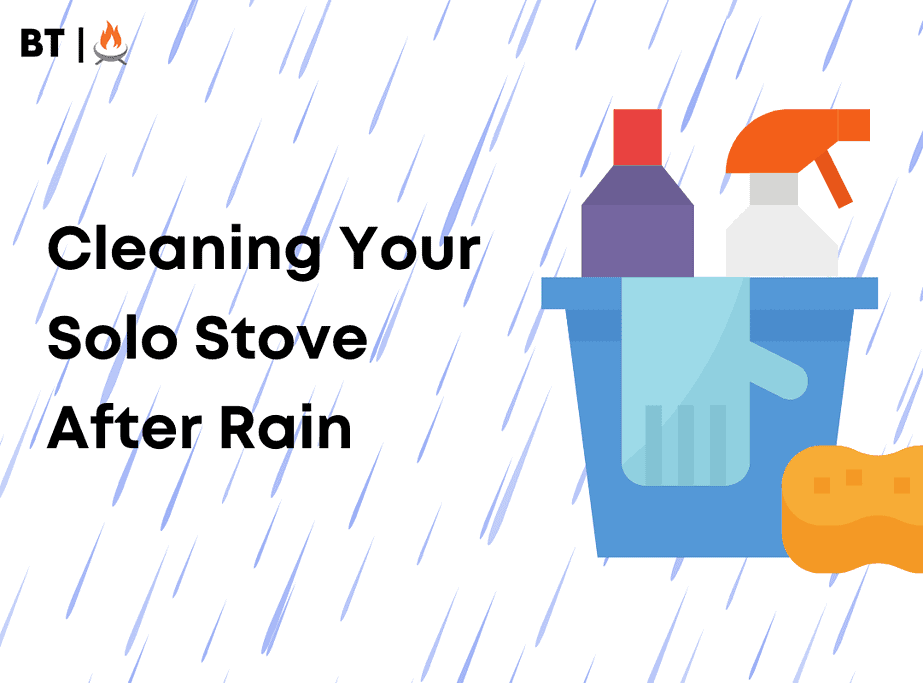
By J. Herwick
We use affiliate links and may receive a small commission on purchases.
Read more about us.
You know that feeling when you realize your brand spanking new Solo Stove got rained on last night? Yeah, that one…
As the proud owner of a previously flawless Solo Stove Yukon, Bonfire, or Ranger, you’ve done everything you can to keep it looking good up until now. Now it’s soaking wet, and the inside is likely a sloppy mess of water-soaked ash and unburnt wood.
Breathe…. ok? Are you still with me? Good. Please repeat after me. It’s-not-a-big-deal. Rainwater will not melt your
It’s like when you get a new car – keeping everyone/everything from putting scratches and dents on your new baby. But, of course, you grin and bear it once it happens. But, on the bright side, it’s done, and you can move on.
Likewise, your
We’ve got the “old-school” 30-inch

Understand, I’m not bragging here (I’m a fire pit geek), just letting you know I’ve been there. So far, two of my three Solo Stoves have rained on, and the sun still managed to come up today.
On a side note, before I’d ever owned a
Anyway, the idea is to keep all of these things to a minimum when and where you can, manage them when they happen, and move on.
For this post, though, we’ll cover what happens when your
No worries, we’ll get your Solo Stove rain issues under control.
Thanks again for reading, and let’s jump in.
Can a Solo Stove Be Left Out In the Rain?
If you read the intro, you already know the answer is yes – you can leave your
The next question is…should you leave your
Aaaand the answer is no, probably not, and here’s why. There are three main reasons why – rust, rust, and rust.
To clarify, before I move on, keeping your
Besides the damage from rusting, it can be a real PITA cleaning up a

Other Fire Pits, Solo Stoves, Rain, and Rust
Before I go on, I want to cover a bit about general fire pit rust (link to my article on the subject).
All fire pits, in general, will start to rust over time, or quickly if used often, as the steel the fire pit is fabricated from, 304 Stainless in the case of Solo Stoves, is exposed to very high temperatures over and over and over.
This intense heat eventually causes specific chemical reactions in the steel, making it less and less rust-resistant.
Ok…so, what is 304 Stainless Steel?
304 Stainless steel is the most common type of stainless steel used in metal fabrication these days. In the past, this variant of stainless steel was referred to as “18/8” because, in addition to containing carbon steel, 304 stainless contains 18% chromium and 8% nickel. 304 stainless is commonly used in modern fire pits due to its durability under high temperatures and corrosion resistance, i.e., resistance to rusting.
This is noticeable in
This is normal and highlights the importance of minimizing the fire pit’s direct exposure to water and other sources of moisture. This isn’t a dig on
The already compromised rust resistance of the steel combined with direct water, humidity, fog, etc. is a recipe for the rapid rusting of the fire pit’s surfaces, particularly inside.
I’ve seen situations where the bottom of a
Fire pit metal is going to break down over time due to high heat conditions – it just speeds up when you add rust to the equation.
Regardless, this is why it’s so important to keep your
As your fire pit becomes less rust-resistant over time, the more you will see rust popping up.
A
The bottom line, the better you can manage this the longer your fire pit will be around.

Cleaning a Solo Stove Left Outside in the Elements
This is the fun part. Just kidding, it’s going to suck…maybe.
Fortunately for most
If you are doing it right (not overloading your
If you are overloading with firewood, there’s a good chance you may have large sections and/or chunks of unburned firewood that need to be removed in addition to the ash.
If you are in the habit of regularly cleaning your
Not to mention, you won’t have to build your next fire on top of wet ash and old firewood. This will help you get your
If not, get ready to get your hands dirty.
5 Steps for Cleaning Out a Solo Stove That Got Rained On
Let’s get into resetting your rained-on
Step 1. Remove unburned firewood/ash from
Due to the vented dome-shaped bottom of all
Also, most of the water from your recent rain shower has passed through the fire pit’s vented dome and has settled in the ash pan along with the ash.
That and the ash on the inside will have to be removed.
Step 1 To-Dos.
- Remove and dispose of all wet unburned firewood from the fire pit
- Clean out all of the ash/water mix on the inside bottom of the fire pit; you’ll likely have to do this by hand as it can be thick and tends to stick to surfaces; focus on the seam running around the perimeter of the bottom to clear out the ash slurry – use your index finger to clear this out; don’t go too crazy yet on cleaning out this whole area, just get the big stuff. You’ll understand why in the next step.
Step 2. Drain: Once you’ve removed the bulk of the visible ash/water mix at the inside bottom of your
Step 2 To-Dos.
- Carefully turn over your
Solo Stove to allow it to drain; if you are cleaning out a Yukon you may want to have someone assist you; also, I recommend using an old nylon tarp on a flat surface to catch any residual ash/water mix
- Once you’ve turned the fire pit over, give the bottom a few gentle downward wraps with your fist to knock out anything that is stuck to the bottom of the ash pan
- Next, leave the fire pit overturned and give it about an hour to let any residual water and any of the ash/water combo seep out
- At this point, you’ll want to gently turn your
Solo Stove back over into its normal position
Step 3. Wipe Down: At this point, we are trying to remove as much of what’s left by wiping down the interior of the fire pit and drying the outside.
Step 3 To-Dos.
- Once the fire pit is upright, thoroughly wipe down the entire inner portion with an old rag or towel, etc. (something you won’t mind dirtying), removing as much ash residue as you are able. Once you’ve done that, use a balled-up paper towel or old sponge to dab up any remaining moisture
- Next, wipe down the exterior of your
Solo Stove with a clean, dry, grit-free towel, or something similar, to dry the outside of the fire pit
Step 4. Let Dry: Once the inside and outside of your fire pit have been wiped down, drying out the interior as quickly as possible is the next step.
Step 4 To-Dos
- If not using the fire pit right away, set it aside in a dry covered location with decent airflow.
- At this point, and if you are able, having a fire is not necessarily a bad thing; a fire will dry out the inside of the fire pit, along with the ash pan area at the base
Step 5. Clean/Polish Exterior (optional, but recommended): Once your

Protect Your Solo Stove Fire Pit from Weather
Now let’s cover how to avoid having to do all of the things we just talked about.
I personally keep my fire pits in my garage when I’m not using them. Once I’ve had a fire, I’ll let it burn out, wait until the fire pit and any contents cool completely, dump the ash, give it a quick wipe down, and put it away.
However, if you use a fire pit regularly enough, there are going to be times when your fire pit is cooling down, or just finished cooling down, and the sky decides to open up.
You can’t cover it because it’s still hot, and you can’t move it, so it gets rained on. BTW, this is how I learned how to clean a rained-on
In reality, there is a solution for this situation as well, beyond just keeping an eye on the weather, and I will talk about it further down.
Rain Protection Options for Your Solo Stove
To keep your
Using a Fire Pit Cover on Your Solo Stove
For those times when the weather cooperates and your fire pit cools down the right way, regular use of a fire pit cover can save you the trouble of a messy clean-up and keep your fire pit in good shape for a lot longer than not using one.
Solo Stove covers, called the Shelter, are made size-specific for the Yukon, Bonfire, and Ranger models. They come in two colors, black and gray, and are very reasonably priced, especially considering the cost of what they’re designed to protect.
The Shelter can be bought separately or with a fire pit bundle for any
If you are looking for a specific color
Whatever option you wind up going with, make sure it’s designed to fit your specific model of

Using a Fire Pit Snuffer or Lid To Keep Rain Out
Another option for keeping rainwater out of your fire pit is using a metal snuffer or lid. These are thin (and typically round) pieces of fabricated sheet metal, sometimes with a handle(s). Snuffers/lids go over a fire pit’s opening to put out fires and keep the rain out when not in use.
Inexpensive options are available on Amazon, and Etsy, and of course,
Like the
Make sure whatever you wind up with covers the diameter of your
I’d recommend an option with 1-2 inches of overhang that extends beyond the edge of the fire pit opening. This ensures complete coverage, ease of placement, and removal if your selection doesn’t have a handle in the center.
If you want a bargain option, people often use steel garbage can lids or large pizza baking pans as covers. Both will definitely keep water out and won’t break the bank.
Using a Solo Stove Station To Protect Your Fire Pit From Rain
One final option before I close out this section is the
I like the idea but it seems a little pricey though. There may be more to it than the pictures and description on
The Solo Stove Station’s reviews on their site are consistently pretty solid, so we’ll see. Click the link to Solo Stove to check it out.
Post Wrap-Up: Can a Solo Stove Get Rained On and What to Do
If your
Keeping your
Thanks again for reading and let’s hope your
